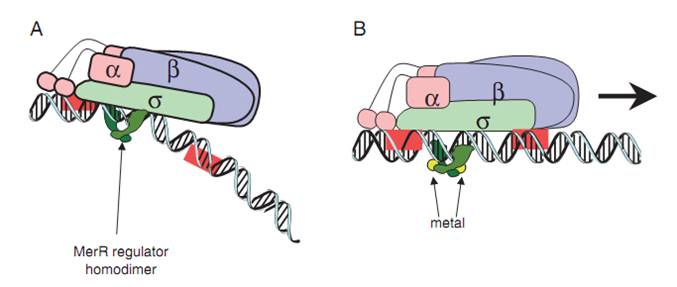Difference between revisions of "Part:BBa K346002:Design"
(→Design Notes) |
(→Design Notes) |
||
| Line 8: | Line 8: | ||
[[Image:MerR-dimer.jpg]] | [[Image:MerR-dimer.jpg]] | ||
| + | |||
| + | (A) The dimeric MerR regulator binds to the operator region of the promoter and recruits RNA polymerase, forming a ternary complex. Transcription is slightly repressed because the apo-MerR regulator dimer has bent the promoter DNA such that RNA polymerase does not contact it properly. (B) Upon binding the cognate metal ions (shown as cyan circles) the metallated MerR homodimer causes a realignment of the promoter such that RNA polymerase contacts the -35 and -10 sequences leading to open complex formation and transcription. Modified from Brown et al. | ||
| + | |||
| + | The mutation of PmerT and the varition of MerR dimer concentration will lead to different sensitivity of Hg(II) in the cell. | ||
===Source=== | ===Source=== | ||
Revision as of 02:47, 24 October 2010
PmerT promoter (mercury-responsive)
- 10COMPATIBLE WITH RFC[10]
- 12COMPATIBLE WITH RFC[12]
- 21COMPATIBLE WITH RFC[21]
- 23COMPATIBLE WITH RFC[23]
- 25COMPATIBLE WITH RFC[25]
- 1000COMPATIBLE WITH RFC[1000]
Design Notes
(A) The dimeric MerR regulator binds to the operator region of the promoter and recruits RNA polymerase, forming a ternary complex. Transcription is slightly repressed because the apo-MerR regulator dimer has bent the promoter DNA such that RNA polymerase does not contact it properly. (B) Upon binding the cognate metal ions (shown as cyan circles) the metallated MerR homodimer causes a realignment of the promoter such that RNA polymerase contacts the -35 and -10 sequences leading to open complex formation and transcription. Modified from Brown et al.
The mutation of PmerT and the varition of MerR dimer concentration will lead to different sensitivity of Hg(II) in the cell.
Source
TTCCATATCGCTTGACTCCGTACATGAGTACGGAAGTAAGGTTACGCTATCCAATCC

